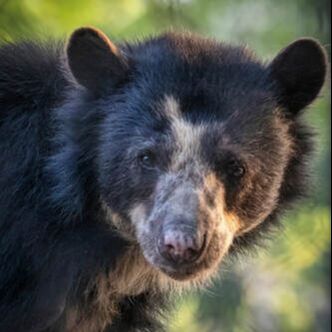Andean Bear

Common Name: Andean Bear
Scientific Name: Tremarctos ornatus1
Physical Description: Andean bears grow 5 to 6 feet long and stand 2 to 3 feet high at the shoulder. Males grow up to 30 percent larger than females, and weigh up to 340 pounds. Females rarely grow heavier than 180 pounds. Each Andean bear has its own distinctive set of cream colored markings on its head, throat and chest.2
Habitat: Andean bears live in a variety of mountain habitats. Many live between 6,000 and 8,800 feet above sea level, with some found at lower elevations. The mountains may contain rainforests, cloud forests, mossy, stunted elfin forest, and thorny dry forest. The Andean bear may visit the grasslands next to forests to forage.2
Range: Andean bears are South America's only bear. They live in the Andes Mountains and outlying mountain ranges2 in Bolivia, Colombia, Ecuador, Peru, and Venezuela.1
Diet: Andean bears are omnivores, eating anything from berries, grasses, bulbs, and cactus flowers to small animals such as rodents, rabbits, and birds. They are unique among bears in that they are mostly herbivorous.2
Life Span: Andean Bears can live into their late 20s in human care. It is unknown how long they can live in the wild.2
Social Structure: Outside of breeding season, spectacled bears travel alone.2
Status: Vulnerable1
Other: During their breeding season, which runs from April to June, males and females stay together for up to two weeks. Females then experience delayed implantation which allows the female to give birth during a time when food is abundant—usually between November and February. If there are insufficient resources, the embryo will not implant. Cubs develop for two to three months after implantation before the female gives birth. The average litter size is one or two cubs.2
References: 1 https://www.iucnredlist.org/species/22066/123792952
2 https://nationalzoo.si.edu/animals/andean-bear
Scientific Name: Tremarctos ornatus1
Physical Description: Andean bears grow 5 to 6 feet long and stand 2 to 3 feet high at the shoulder. Males grow up to 30 percent larger than females, and weigh up to 340 pounds. Females rarely grow heavier than 180 pounds. Each Andean bear has its own distinctive set of cream colored markings on its head, throat and chest.2
Habitat: Andean bears live in a variety of mountain habitats. Many live between 6,000 and 8,800 feet above sea level, with some found at lower elevations. The mountains may contain rainforests, cloud forests, mossy, stunted elfin forest, and thorny dry forest. The Andean bear may visit the grasslands next to forests to forage.2
Range: Andean bears are South America's only bear. They live in the Andes Mountains and outlying mountain ranges2 in Bolivia, Colombia, Ecuador, Peru, and Venezuela.1
Diet: Andean bears are omnivores, eating anything from berries, grasses, bulbs, and cactus flowers to small animals such as rodents, rabbits, and birds. They are unique among bears in that they are mostly herbivorous.2
Life Span: Andean Bears can live into their late 20s in human care. It is unknown how long they can live in the wild.2
Social Structure: Outside of breeding season, spectacled bears travel alone.2
Status: Vulnerable1
Other: During their breeding season, which runs from April to June, males and females stay together for up to two weeks. Females then experience delayed implantation which allows the female to give birth during a time when food is abundant—usually between November and February. If there are insufficient resources, the embryo will not implant. Cubs develop for two to three months after implantation before the female gives birth. The average litter size is one or two cubs.2
References: 1 https://www.iucnredlist.org/species/22066/123792952
2 https://nationalzoo.si.edu/animals/andean-bear






